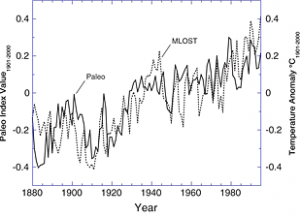Evidence Of Global Warming
From article by Alex Knapp, Forbes Staff, February 21, 2013
One of the biggest challenges of climate science should be one of the easiest; measuring temperatures. The fact is, regular measurements of temperature around the globe didn’t begin in real earnest until the late 19th century. So when scientists want to understand what temperatures were like prior to that era, they have to use proxies.
For example, scientists can tell by the way ice crystallizes what the weather and temperature was like thousands of years ago in ice core samples from polar regions. In the modern era, although there have been steady measurements, they’ve taken place at different sites at different times with different technologies, which means some heavy math can come into play to normalize that data well enough to see clear trends.
That’s what makes this recent study pretty interesting. In it, a group of researchers applied those paleoclimatology techniques of finding temperature proxies to the modern era, where there is a clear temperature record. If those proxies match global temperature measurements, then it would provide independent confirmation of the global warming trend of the past couple of centuries, without being tangled up in some of the difficulties involved in normalizing the measurements.
To construct their temperature record, the researchers used 173 different proxy sources for temperature from around the globe. These proxies include coral, ice cores, mineral deposits in caves, lake and ocean sediments, as well as a few historical records like grape harvest dates. Additionally, the authors specifically excluded data, such as tree ring examinations, that have proved controversial in recent years.
They then used that proxy data, which they dubbed the Paleo Index (PI) and compared it to the merged land-ocean surface temperature (MLOST) records developed by the National Climactic Data Center. As you can see in the graph to the right, the temperature trends from the PI strongly correlate with that from MLOST.
As a secondary measure, the PI was also extrapolated back from 1880 (where the comparison to MLOST begins) back to 1730. Using that data, the authors found that global warming trends began in about the year 1800, just as the industrial revolution was gaining steam.
This is a significant finding because, as the authors of the paper note, “The global-average time series compiled from 170 temperature-sensitive paleo proxies indicates a significant warming trend from 1880–1995. Derived from multiple proxies with global distribution, the PI provides independent evidence of the warming observed in the thermometer-based record.”
This independent confirmation neatly side-steps some of the controversies around global warming centering on temperature measurements. That’s because many of the claims of skeptics to explain the effect – such as the “urban heat-island” – don’t apply to the proxies. What’s more, the fact that the proxies show large agreement with the measured temperature record provides additional reason to accept that despite the changes in temperature measurement that have occurred over the past century, climatologists have been pretty precise in adjusting for those changes when deriving global trends.
In other words, this is just one more piece of evidence on top the staggering pile of evidence demonstrating the simple fact that average global temperatures have been increasing over the past two centuries.


{ 1 comment… read it below or add one }
Global warming is better than global cooling. Global cooling results in decreased crop yields and the potential for mass starvation.
Seeing as we are only 10,000 years out of an ice age, I would expect over the next million years we will keep warming up.